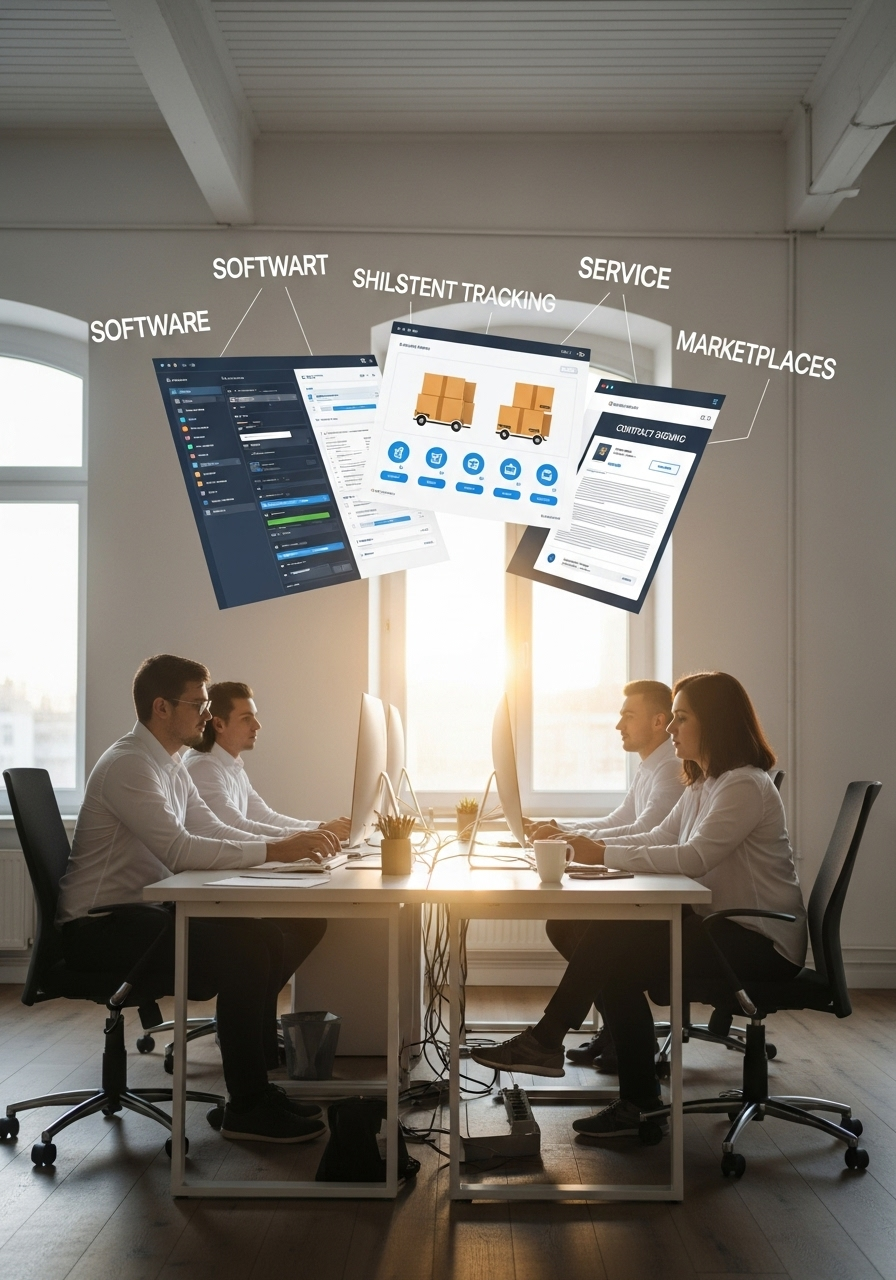The three pillars of B2B innovation?
AI, marketplaces and open source are not standalone trends but a deeply intertwined reality that is rewriting the rules of the game.
AI as co-pilot
Artificial intelligence is no longer an add-on tool but a fundamental partner that automates processes, generates deep insights and rebuilds the B2B stack from the ground up, augmenting human capacity rather than replacing it.
Next-generation marketplaces
Forget the simple product catalogue. The new B2B marketplaces are dynamic ecosystems that seamlessly integrate workflow, payments, communication and even complex project management into a single fluid experience.
The power of open source
Open source is the engine behind faster innovation and adoption. It lowers the barriers for users to get started while creating a community-driven development model that increasingly leaves traditional closed systems behind.
The intertwined reality
AI, marketplaces and open source are not standalone trends but a deeply intertwined reality that is rewriting the rules of the game.
AI is more than a feature; it is the new B2B foundation

The a16z vision, frequently highlighted in their publications and podcasts, shows that generative AI is fundamentally rewriting the way B2B software is built, sold and used.
For years we talked about SaaS — Software as a Service. What we are witnessing now, however, is a shift that runs far deeper. The arrival of powerful, accessible AI models, especially generative AI, is changing the entire architecture of B2B software. It is no longer a ‘‘feature’’ you bolt on, like a chatbot tucked away in the corner of your screen. It is the very foundation on which the next generation of companies is built.
In practice you often see companies struggle with this transition. They try to slap AI on top of their existing — often outdated — systems. A ‘‘thin layer of intelligence’’ over a dumb database, so to speak. That is a dead-end street. Tomorrow’s winners are building their products around AI from the very first line of code.
From ‘‘system of record’’ to ‘‘system of intelligence’’
A concept that sits at the heart of this shift is the evolution from ‘‘systems of record’’ to ‘‘systems of intelligence’’. Your system of record is your source data: your CRM, your ERP, your customer database. For decades the value of software lay in accurately keeping track of that data. Yet data on its own does nothing; it is passive.
A system of intelligence, by contrast, actively uses that data to assist, advise and automate tasks for the user. Think of a CRM that not only stores contact details but proactively suggests the next sales action based on email traffic, market sentiment and the account manager’s calendar. Or supply-chain software that not only tracks inventory but autonomously calculates the most optimal ordering moments and transport routes based on thousands of variables. That is the essence: the software becomes an active partner, a co-pilot.
The impact on the business model is enormous
And this has far-reaching consequences. The traditional B2B sales model — with long sales cycles, demos and fixed licence fees per user per month — often no longer fits. When the value of your product is directly linked to usage (the more data the AI processes, the more valuable the output), consumption-based pricing models suddenly make much more sense. You pay for results, not for access.
What stands out to me is how this also changes the nature of competitive advantage. In the past your moat may have been a technological lead or a strong sales team. Today your moat is increasingly the unique dataset your AI is trained on and the feedback loops from your users. The more people that use your product, the smarter it becomes — and the harder it is for a competitor to catch up. A powerful flywheel, provided you set it up correctly.
The reinvention of B2B marketplaces

The next generation of B2B marketplaces is not about simply matching supply and demand, but about orchestrating complex relationships and integrated processes.
We all know B2C marketplaces like Bol.com or Airbnb. But B2B is a completely different beast. Transactions are more complex, ticket sizes are larger and the trust factor is infinitely more important. A consumer who orders the wrong book sends it back. A contractor who orders the wrong prefab walls via a platform faces a catastrophe that can halt an entire project.
That’s why many early B2B marketplaces failed. They were little more than a glorified Yellow Pages: a list of suppliers and a contact form. The real value isn’t in the connection but in everything that follows. The a16z mindset emphasises that successful B2B marketplaces take over the entire workflow.
From ‘‘listings’’ to workflow orchestration
So what does it mean to take over the workflow? It means the marketplace provides software for:
Quotations and negotiations: Structured processes to reach a deal.
Contract management: Legally binding agreements directly on the platform.
Project management & communication: A single central place where all parties can track progress and communicate, instead of endless email chains.
Embedded finance: Integrated financial services such as escrow (where the funds are held until the job is done), invoicing and even ‘‘Buy Now, Pay Later’’ solutions for corporate spend.
By integrating these elements, the marketplace becomes indispensable. It is no longer just the place where you find a supplier, but the place where you get the job done. This massively increases stickiness and justifies a higher take rate because you deliver far more than a lead; you deliver a well-oiled process.
The role of trust and data
In B2B, trust is everything. A successful marketplace must therefore invest heavily in vetting suppliers, making reviews transparent and insuring transactions. And this is where data, as I mentioned earlier, comes into play again. A marketplace processing thousands of transactions gathers a wealth of information. Which suppliers deliver on time? What is a fair price for a given service in a specific region? This data can then be used to make the platform smarter — with better matching, accurate price benchmarks and risk analyses. And so the circle closes, and the marketplace builds a deep, data-driven competitive advantage. It is a self-reinforcing mechanism.
Open source: the quiet engine behind B2B disruption

It's long since stopped being about ‘‘free software’’. It's a fundamentally different go-to-market and innovation model that perfectly matches the modern B2B buyer.
Open source still carries a somewhat amateurish, almost philanthropic image among those at a distance — as if it's something hobbyists build in an attic. Nothing could be further from the truth. In the world of B2B software, open source has become a razor-sharp commercial strategy that upends traditional top-down sales models. And it's brilliant.
Why? Because the modern B2B buyer — especially for a technical product — no longer fancies a sales call. They don't want to hear about ‘‘synergy’’ and ‘‘paradigm shifts’’. They want to try the product themselves. Immediately. Without filling in a form and waiting three weeks for a demo.
The bottom-up sales model
And that is exactly what open source facilitates. The model, often referred to as ‘‘commercial open-source software’’ (COSS), usually works like this:
Create an open-source project that solves a painful, specific problem for a developer, data analyst or other technical user.
Build a community of users and contributors around this project. This becomes your most valuable asset. The community provides feedback, word-of-mouth marketing and a constant stream of product ideas — your marketing and R&D departments rolled into one.
Launch a commercial product on top of the open-source project. This is often a managed cloud version that removes all the hassle of hosting and maintenance, or an enterprise version with extra features large companies need, such as advanced security, auditing and support.
The genius here is that adoption happens before a single salesperson gets involved. A developer at a large company starts using your open-source tool for a small project. Colleagues see it and start using it too. Before you know it, your software is running on dozens of systems within that organisation. At that point, the need for a central, managed solution becomes so great that the department's manager naturally approaches you for your commercial offering. It's a sales model that sells itself.
Beyond the code: trust and transparency
But the power of open source goes further than just the go-to-market strategy. It builds trust. Because the code is public, users can see exactly what the software does. There are no hidden agendas. For companies that increasingly rely on software for their core processes, that transparency is priceless. It creates a bond with your users that you can hardly ever achieve with closed-source software. It's a fundamentally different — and in today's world often far stronger — relationship.
How do you navigate this new B2B reality?.
Theory is fascinating, but the value lies in translating it into practice. Here is a step-by-step approach to implementing the a16z insights without choking on the complexity.

Step 1: Obsess over your customer's workflow.
Before you write a single line of code for an AI feature, you must know your target audience's workflow inside out. Where is the most friction? Where do the costliest mistakes occur? Where is the most time lost in repetitive, mind-numbing tasks? Map that mercilessly. It is tempting to start with the technology, but you must start with the problem. Your product must be a solution, not a technological demo.

Step 2: Identify your unique ‘‘system of record’’.
What is the data that only your company can collect or structure in a unique way? Is it data on logistical movements? Data on marketing-campaign performance? Data on legal contracts? This is the crude oil. Without a unique, robust dataset, any system of intelligence you build is a house of cards. Defend and enrich this dataset as if your life depends on it — because your company's probably does.

Step 3: Choose your community model deliberately.
You don''t build a community ‘‘on the side’’. It''s a strategic decision that influences everything. Open source: Perfect for technical products with developers as end users. It leads to rapid bottom-up adoption and technical validation. The challenge? Converting to a paid product. Marketplace ecosystem: Ideal for markets with fragmented buyers and sellers. It creates a flywheel effect. The challenge? Solving the chicken-and-egg problem and building trust. You can''t do everything at once, so choose the model that best fits your product and audience.

Step 4: Experiment with your pricing model.
Abandon the idea that one pricing model is sacred. If you deliver value through AI and automation, it makes sense to link your price to that value. Start by measuring usage. How many tasks does your tool automate? How many reports does it generate? Attach a price point to that, even if only internally at first. This forces you to think about where the real customer value lies and paves the way for a more flexible and fair pricing model in the future.
The playing field has changed. What does this mean in concrete terms?.
The playing field has changed. What does this mean in concrete terms?

Traditional B2B silos are crumbling fast. You can no longer think in terms of ‘‘we sell software’’, ‘‘we run a marketplace’’ or ‘‘we maintain an open-source project’’. The most successful companies of the next decade will be a mix of all three. A marketplace without AI-driven recommendations feels dumb. An AI tool without a community or ecosystem struggles to gain traction. And open source is often the fastest route to that community. It's a mutually reinforcing system. The biggest pitfall is to see these elements as standalone projects rather than the core of your strategy.
It really boils down to a few fundamental shifts in how you think about your business:
Focus on the entire workflow: Winning B2B solutions are not merely tools but platforms that manage and improve the user's full, often complex, workflow from start to finish.
Intelligence as the heart of your product: Data and AI are no longer ‘‘nice-to-haves’’ or departments; they form the beating heart of the product value you deliver to the customer.
Community is the new GTM strategy: A loyal community, built via an open-source project or a dynamic marketplace, is a far more sustainable go-to-market strategy than simply buying more ads.
Vertical dominance as an opportunity: The biggest opportunities may well lie in vertical SaaS — deep, industry-specific solutions for sectors such as construction, legal or biotech, rather than broad, horizontal tools that work ‘‘a bit’’ for everyone.


Ready to take the next step?
The theory is clear, the concepts are powerful, but implementation is where the real, complex work begins. Every market, every company and every customer is unique. Are you brimming with new ideas after reading this analysis, or can't see the wood for the trees? It can be overwhelming — we understand. Let's spar without obligation. No canned sales pitch, but an honest, strategic conversation about where the real opportunities lie for your business in this new B2B reality.
Is this shift towards AI and marketplaces only relevant for tech start-ups?
Absolutely not — that's a common misconception. In fact, established companies often have a huge advantage that start-ups lack: an existing customer base and, more importantly, a wealth of historical data (a ‘‘system of record’’). The challenge for an established business is not a lack of resources but the courage to scrutinise existing business models and processes. The transition may be harder for a large incumbent, but the upside is at least as great. It's about building a ‘‘system of intelligence’’ on the foundations you already have.
What exactly do you mean by ‘‘vertical SaaS’’?
Vertical SaaS is software designed specifically for a single industry or niche. Think of software for dental practices, vineyard management or law firms. Horizontal SaaS, such as Slack or Microsoft Office, is built to be used by anyone in any industry. The power of vertical SaaS is that it can delve much deeper into the unique, complex workflows of that specific sector, delivering far more value — value customers are willing to pay for. Often these vertical SaaS solutions evolve into the central marketplace and ‘‘operating system’’ for the entire industry.
Isn't an open-source model just giving your product away for free? How do you make money from that?
That''s the classic question, and the answer is layered. You give the base version away to remove friction and drive rapid, broad adoption. That''s your marketing. You then make money with ‘‘on-top’’ services. The most common models are: Managed Hosting/Cloud: You offer a fully managed, turnkey cloud version of your software. Customers pay for convenience, scalability and maintenance. Think GitLab or Confluent. Open Core: The core of the software is open source, but you sell a commercial version with extra enterprise-grade features such as advanced security, compliance and analytics. Support & Services: You sell paid support contracts, training and consultancy. The essence is: you give away the code, but you sell the solution to big-company problems.
Our B2B transactions are too complex for a marketplace. Is this realistic?
This is a common and valid point. It's unrealistic to think that a multi-million-pound bespoke contract can be fully automated via a simple ‘‘click-and-buy’’ marketplace. But that's not the goal. The goal is to support and streamline the workflow surrounding that complex transaction. Think standardising the initial RFQ, managing the document flow during due diligence, facilitating communication between ten different stakeholders, or tracking project milestones and stage payments after the deal is signed. Even in the most complex B2B environments, a marketplace can remove huge amounts of friction — even if the final signature still happens on paper.
How do I start collecting the right data for AI if we don't have anything structured yet?
Start small and focus on one painful problem. Choose one process that currently involves a lot of manual work. Begin logging all steps and data points in that process, even if it's in a simple spreadsheet. The goal isn't to have a perfect, all-encompassing data warehouse from day one; it's to create an initial, unique dataset — however small. From there you can iterate. Which data is missing to automate this process? How can we start capturing that data? It's a step-by-step journey, not a big bang.
What's the biggest mistake companies make when implementing these ideas?
The single biggest mistake is treating technology as the goal rather than the means. Companies get excited about ‘‘AI’’ and then go hunting for a problem to solve with AI, instead of the other way around. They start an ‘‘AI project’’ that sits outside the company's core strategy. This almost always leads to expensive, technologically impressive projects that ultimately deliver zero real business value. Whether it's AI, a marketplace or open source, the technology must always serve the purpose of solving a fundamental customer problem and reinforcing your core business. Always.










.webp)
